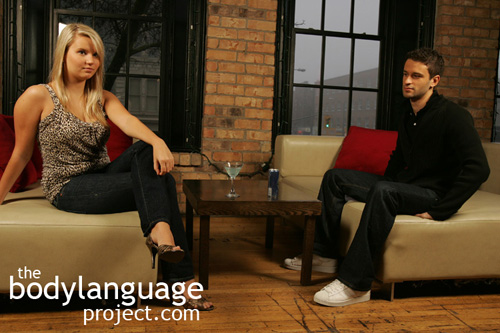Body Language of Direct Eye Contact
Synonym(s): Eye Contact
Description: Eyes that meet someone else’s (versus looking away or at the mouth, chin, or body).
In One Sentence: Direct eye contact signals to others that one is intently listening and focused on the person whose eyes they have met.
How To Use it: Use direct eye contact to signal that you are dominant and can withstand reciprocal eye contact without wavering. Alternatively, use eye contact in dating to signal sexual interest. While with friends, eye contact can also send a warm glow when it is not done in a piercing fashion. Various cultures use direct eye contact in different ways – therefore, it would pay to be conscious of these social norms when traveling.
Context: a) General, b) Dating.
Verbal Translation: “I’m interested in you and I want you to know that so my eyes are meeting yours.”
Variant: Eyes are an important source of information; see other eye cues for more details. See Friendly Social Gaze, Staring or The Evil Eye, Gaze Omission, Gazing Adoringly, Intimate Gaze (The) or Triangular Gaze Pattern.
Cue In Action: When speaking, the lovers made frequent eye contact.
Meaning and/or Motivation: An indication of active honest listening. Practiced liars feign eye contact to study whether or not a lie is being rejected or accepted. In a dating context, direct eye contact is a sign of interest. The meaning of direct eye contact is hugely varied and one should look at the associated cues to determine the true intent of direct eye contact.
Eye contact can be piercing and studied, an attack, or alluring and coy such as gazing. See variants for more specific meaning of eye contact.
Cue Cluster: Varied depending on context.
Body Language Category: Amplifier, Arousal, Attentive, Aggressive body language, Anger, Authoritative body language, Courtship display, Confident, Dominant body language, High confidence body language, Indicator of interest (IoI), Leadership body language, Liking, Rapport or rapport building.
Resources:
Argyle, M., & Dean, I. Eye contact, distance and affiliation. Sociometry, 1965, 28, 289-304.
Aviva Musicus, Aner Tal, and Brian Wansink. Eyes in the Aisles: Why is Cap’n Crunch Looking Down at My Child? Environment & Behavior. 2014. Forthcoming.
http://bodylanguageproject.com/articles/eyes-in-the-aisles-why-is-capn-crunch-looking-down-at-my-child/
Aguinis, Herman ; Simonsen, Melissam. ; Pierce, Charlesa. Effects of Nonverbal Behavior on Perceptions of Power Bases. The Journal of Social Psychology. 1998. 138(4): 455-469.
Aguinis, Herman ; Henle, Christinea. Effects of Nonverbal Behavior on Perceptions of a Female Employee’s Power Bases. The Journal of Social Psychology. 2001 141(4): 537-549.
Bowers, Andrew L. ; Crawcour, Stephen C. ; Saltuklaroglu, Tim ; Kalinowski, Joseph
Gaze aversion to stuttered speech: a pilot study investigating differential visual attention to stuttered and fluent speech. International Journal of Language & Communication Disorders. 2010. 45(2): 133-144.
Baxter, James C., and Richard M. Rozelle (1975). “Nonverbal Expression as a Function of Crowding During a Simulated Police-Citizen Encounter.” In Journal of Personality and Social Psychology (Vol. 32, No. 1), pp. 40-54.
Beausoleil, Ngaio J. ; Stafford, Kevin J. ; Mellor, David J. Burghardt, Gordon M. (editor). Does Direct Human Eye Contact Function as a Warning Cue for Domestic Sheep (Ovis aries)? Journal of Comparative Psychology. 2006. 120(3): 269-279.
Baltazar M; Hazem N; Vilarem E; Beaucousin V; Picq JL, and Conty L. Eye Contact Elicits Bodily Self-Awareness in Human Adults. Cognition. 2014. 133 (1): 120-7 PMID: 25014360
http://bodylanguageproject.com/articles/eye-contact-makes-us-uncomfortable-curious-case-stare-rape/
Bolmont, Mylene; John T. Cacioppo and Stephanie Cacioppo. Love Is in the Gaze: An Eye-Tracking Study of Love and Sexual Desire. Psychological Science July 16, 2014. Published online before print. July 16, 2014, doi: 10.1177/0956797614539706
http://bodylanguageproject.com/articles/lust-like-eyes-read-body-language-eyes/
Brooks, C. I., Church, M. A., & Fraser, L. 1986. Effects of duration of eye contact on judgments of personality characteristics. Journal of Social Psychology. 126: 71–78.
Beekman, S. The relation of gazing and smiling behaviors to status and sex in interacting pairs of children. Unpublished master’s thesis, University of Chicago, 1970.
Bond, C. F., Kahler, K. N., & Paolicelli, L. M. (1985). The miscommunication of deception: An adaptive perspective. Journal of Experimental Social Psychology, 21, 331–345. doi:10.1016/0022-1031(85)90034-4
Burns, J. A., & Kintz, B. L. (1976). Eye contact while lying during an interview. Bulletin of the Psychonomic Society, 7, 87–89.
Chen, Frances S, Minson, Julia A ; Schöne, Maren ; Heinrichs, Markus. In the Eye of the Beholder, Psychological Science. 2013; 24(11): 2254-2261.
http://bodylanguageproject.com/articles/eye-contact-increases-resistance-to-persuasion/
Davis 1978. Camera Eye-Contact by the Candidates in the Presidential Debates of 1976 Source: The journalism quarterly. 55 (3): 431 -437.
Davis, Flora (1971). Inside Intuition: What We Know About Nonverbal Communication (San Francisco: McGraw-Hill).
Einav, Shiri ; Hood, Bruce M. García Coll, Cynthia (editor). Tell-Tale Eyes: Children’s Attribution of Gaze Aversion as a Lying Cue. Developmental Psychology. 2008. 44(6): 1655-1667.
Ellsworth, Phoebe; Carlsmith, J Merrill. 1973. Eye contact and gaze aversion in an aggressive encounter. Journal of Personality and Social Psychology. 28(2): 280-292.
Givens D. The nonverbal basis of attraction: Flirtation, courtship, and seduction. Psychiatry. 1978. 41: 346.
Geangu, Elena; Petra Hauf; Rishi Bhardwaj and Wolfram Bentz. Infant Pupil Diameter Changes in Response to Others’ Positive and Negative Emotions. 2011. PLoS ONE 6(11): e27132. doi:10.1371/journal.pone.0027132
http://bodylanguageproject.com/articles/distress-happiness-reflected-infants-eyes/
Guéguen, Nicolas and Céline Jacob. Direct Look Versus Evasive Glance and Compliance With a Request, The Journal of Social Psychology. 2002.142(3): 393-396. DOI: 10.1080/00224540209603907. http://dx.doi.org/10.1080/00224540209603907
http://bodylanguageproject.com/articles/direct-eye-contact-best-making-request/
Gordon, A. K. and A. G. Miller. 2000. Perspective differences in the construal of lies: is deception in the eye of the beholder? Personality and Social Psychology Bulletin 26 (1): 46-55.
Gilliam, Harold V. B.; Van Den Berg, Sjef. 1980. Different Levels of Eye Contact: Effects on Black and White College Students. Urban Education. 15 (1): 83-92.
Goldman. 1980. Effect of Eye Contact and Distance on the Verbal Reinforcement of Attitude. The Journal of social psychology 111(1): 73 -78.
Greene 1979. Title: Need-Fulfillment and Consistency Theory: Relationships Between Self-Esteem and Eye Contact. Source: Western journal of speech communication. 43(2): 123 -133.
Galin, D. and Ornstein, R., 1974. Individual Differences in Cognitive Style – Reflective Eye Movements; Neuropsychologia, 12: 376-397.
Hocking. 1985. Eye contact contrast effects in the employment interview. Communication research reports 2(1): 5-10.
Horley K, Williams LM, Gonsalvez C, Gordon E (2003) Social phobics do not see eye to eye: a visual scanpath study of emotional expression processing. J Anxiety Disord 17:33–44
Hemsley, G. D., & Doob, A. N. (1978). The effects of looking behavior on perceptions of a communicator’s credibility. Journal of Applied Social Psychology, 8, 136–144. doi: 10.1111/j.1559-1816.1978.tb00772.x
Haith, M. M., Bergman, T., & Moore, M. J. (1979). Eye contact and face scanning in early infancy. Science, 198, 853–855.
J. E. S. Choi, P. A. Vaswani, R. Shadmehr. Vigor of Movements and the Cost of Time in Decision Making. Journal of Neuroscience, 2014; 34 (4): 1212.
http://bodylanguageproject.com/articles/eye-movements-may-indicate-impatience-and-impulsivity/
Johansson-Stenmen, O. (2008). Who are the trustworthy, we think? Journal of Economic Behavior & Organization, 68, 456–465. doi:10.1016/j.jebo.2008.08.004
Keating, C. F., Mazur, A., & Segall, M. H. Facial gestures which influence the perception of status. Sociometry, 1977, 40, 374-378.
Kinsbourne, M., 1972. Eye and Head Turning Indicates Cerebral Lateralization; Science, 179: 539-541.
Kocel, K., et al.,1972. Lateral Eye Movement and Cognitive Mode; Psychon Sci. 27: 223-224.
Knackstedt, G., & Kleinke, C. L. (1991). Eye contact, gender, and personality judgments. Journal of Social Psychology, 131: 303-304.
Konopacki 1987. Eye Movement Betrays a Prospect’s Inner Feelings Source: Marketing news 21(10): 4.
Kampe, K.K.W. ; Frith, C.D. ; Dolan, R.J. ; Frith, U. Direct eye contact with attractive faces activates brain areas associated with ‘reward’ and ‘reward expectation’ Neuroimage. 2001. 13(6): 425-425.
Lauri Nummenmaa; Jukka Hyönä and and Jari K. Hietanen. I’ll walk this way: Eyes Reveal the Direction of Locomotion and Make Passersby Look and Go the Other Way. Journal of The Association for Psychological Science. 2009. 20(12):1454-1458.
http://bodylanguageproject.com/articles/eye-can-tell-youre-walking-way-read-body-language-eyes
Lee Ann Renninger, T. Joel Wade, Karl Grammer. Getting that female glance: Patterns and consequences of male nonverbal behavior in courtship contexts. Evolution and Human Behavior. 2004; 25: 416–431.
http://bodylanguageproject.com/articles/part-i-how-to-read-male-sexual-body-language-a-study-for-women-and-the-men-who-wish-to-cheat-the-system/
Lance, Brent ; Marsella, Stacy. Glances, glares, and glowering: how should a virtual human express emotion through gaze? Autonomous Agents and Multi-Agent Systems, 2010. 20(1): 50-69
Langer, Julia and Rodebaugh, Thomas. Social Anxiety and Gaze Avoidance: Averting Gaze but not Anxiety. Cognitive Therapy and Research, 2013, Vol.37(6): 1110-1120.
Levine TR, Asada KJK, Park HS (2006) The lying chicken and the gaze avoidant egg: eye contact, deception and causal order.
Mobbs, N.A. 1968. Eye-contact in Relation to Social Introversion-Extraversion. British Journal of Social Clinical Psychology 7: 305-306.
Moore, Monica. Courtship Signaling and Adolescents: Girls Just Wanna Have Fun. Journal of Sex Research. 1995. 32(4): 319-328.
http://bodylanguageproject.com/articles/girls-just-want-to-have-fun-the-origins-of-courtship-cues-in-girls-and-women/
Maslow, A.H. Dominance-feeling, behavior, and status. Psychological Review, 1937, 44, 404-429.
Matsuda, Yoshi-Taka ; Okanoya, Kazuo ; Myowa-Yamakoshi, Masako. Syness in early infancy: approach-avoidance conflicts in temperament and hypersensitivity to eyes during initial gazes to faces. PloS one. 2013 8(6): pp.e65476
Moukheiber A, Rautureau G, Perez-Diaz F, Soussignan R, Dubal S, Jouvent R, Pelissolo A (2010) Gaze avoidance in social phobia: objective e measure and correlates. Behav Res Ther 48:147–151.
Mccarthy, Anjanie ; Lee, Kang. Children’s Knowledge of Deceptive Gaze Cues and Its Relation to Their Actual Lying Behavior. Journal of Experimental Child Psychology. 2009. 103(2): 117-134.
Mann, Samantha ; Ewens, Sarah ; Shaw, Dominic ; Vrij, Aldert ; Leal, Sharon ; Hillman, Jackie. Lying Eyes: Why Liars Seek Deliberate Eye Contact. Psychiatry, Psychology and Law. 2013. 20(3): 452-461.
Modigliani, A. (1971). Embarrassment, facework, and eye contact: Testing a theory of embarrassment. Journal of Personality and Social Psychology, 17, 15–24.
Ponari, Marta ; Trojano, Luigi ; Grossi, Dario ; Conson, Massimiliano. “Avoiding or approaching eyes”? Introversion/extraversion affects the gaze-cueing effect. Cognitive Processing. 2013. 14(3): 293-299.
Rutter, D.C; D. C. Pennington, M. E. Dewey and J. Swain. 1984. Eye-contact as a chance product of individual looking: Implications for the intimacy model of Argyle and Dean. Source: Journal of nonverbal behavior. 8(4): 250-258.
Richard Tessler and Lisa Sushelsky. 1978. Effects of eye contact and social status on the perception of a job applicant in an employment interviewing situation. Journal of Vocational Behavior 13(3): 338-347.
Riggio, R. E., & Friedman, H. S. (1983). Individual differences and cues to deception. Journal of Personality and Social Psychology, 45, 899–915. doi: 10.1037/0022-3514.45.4.899
Stern, Daniel and Estelle Bender (1974). “An Ethological Study of Children Approaching a Strange Adult.” In Richard Friedman et al. (Eds.), Sex Differences in Behavior (New York: John Wiley and Sons), pp. 233-58.
Senju, A., & Johnson, M. H. (2009). The eye contact effect: Mechanisms and development. Trends in Cognitive Science, 13, 127–134.
Slessor, Gillian ; Phillips, Louise H. ; Bull, Rebecca ; Venturini, Cristina ; Bonny, Emily J. ; Rokaszewicz, Anna. Investigating the “deceiver stereotype”: do older adults associate averted gaze with deception?(Author abstract). The Journals of Gerontology, Series B. 2012. 67(2): 178(6).
Sporer, S. L., & Schwandt, B. (2007). Moderators of nonverbal indicators of deception: A meta-analytic synthesis. Psychology, Public Policy and Law, 13, 1–34. doi: 10.1037/1076-8971.13.1.1
Sitton, Sarah C; Griffin, Susan T. 1981. Detection of deception from clients’ eye contact patterns. Journal of Counseling Psychology. 28(3): 269-271.
Strick, Madelijn ; Holland, Rob W. ; Van Knippenberg, Ad. Seductive Eyes: attractiveness and Direct Gaze Increase Desire for Associated Objects Cognition. 2008. 106(3): 1487-1496.
Scherer, S. E., & Schiff, M. R. Perceived intimacy, physical distance, and eye contact. Perceptual and Motor Skills, 1973, 36, 835-841.
Sturman, Edward D. Invluntary Subordination and Its Relation to Personality, Mood,
and Submissive Behavior. Psychological Assessment. 2011. 23(1): 262-276 DOI: 10.1037/a0021499
http://bodylanguageproject.com/articles/nonverbal-submission-men-women-depression-critical-examination-use-disuse-submission/
Strongman, K. T., & Champness, B. G. Dominance hierarchies and conflict in eye contact. Acta Psychologica, 1968, 2& 376-386.
Terburg, David; Henk Aarts and Jack van Honk. Testosterone Affects Gaze Aversion From Angry Faces Outside of Conscious Awareness. Psychological Science. 2012; 23 (5) 459-463.
http://bodylanguageproject.com/articles/testosterone-mediates-eye-gaze-patterns-against-angry-faces/
Straube, Thomas ; Langohr, Bernd ; Schmidt, Stephanie ; Mentzel, Hans-Joachim ; Miltner, Wolfgang H.R. Increased amygdala activation to averted versus direct gaze in humans is independent of valence of facial expression. NeuroImage. 2010 49(3): 2680-2686.
Vrij, A., & Semin, G. R. (1996). Lie experts’ beliefs about nonverbal indicators of deception. Journal of Nonverbal Behaviour, 20, 65–81. doi: 10.1007/BF02248715
Wu, D.W-L.; Walter Bischof and Alan Kingstone. Natural Gaze Signaling in a Social Context. Evolution and Human Behavior. 2014. http://dx.doi.org/10.1016/j.evolhumbehav.2014.01.005
http://bodylanguageproject.com/articles/dont-look-at-me-im-chewing-dont-worry-i-wont-eye-language-and-the-white-of-your-eyes/
Wirth, James H ; Sacco, Donald F ; Hugenberg, Kurt ; Williams, Kipling D. Eye gaze as relational evaluation: averted eye gaze leads to feelings of ostracism and relational devaluation. Personality & social psychology bulletin. 2010 36(7): 869-82.
Wang, Yin ; Newport, Roger ; Hamilton, Antonia F De C. Eye contact enhances mimicry of intransitive hand movements. Biology letters. 2011. 7(1): 7-10.
Wirth, James H ; Sacco, Donald F ; Hugenberg, Kurt ; Williams, Kipling D. Eye gaze as relational evaluation: averted eye gaze leads to feelings of ostracism and relational devaluation. Personality & social psychology bulletin. 2010 36(7): 869-82.
Walsh, D. G., & Hewitt, J. (1985). Giving Men The Come-On: Effect Of Eye Contact And Smiling In A Bar Environment. Perceptual and Motor Skills, 61, 873-874.




